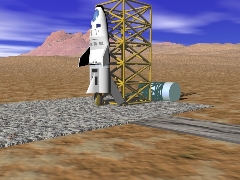
 |
|||||||
|
|
|
|
|
|
|
|
|
|
Sub-Orbital |
Orbital |
LEO Station |
Mission Statement |
Lunar Orbit |
Lunar Surface |
Mars and Beyond |
Since 1996, the X Prize
Foundation has offered a $10M reward for the first privately funded vehicle
capable of taking three people to 100km altitude and repeating the feat within
two weeks. Universal Expeditions is not interested in the X Prize as
such, but it does provide a good design specification for a sub-orbital
vehicle. The design detailed here probably doesn't meet the "privately
developed and funded" part of the criteria, but it offers a quick way to adopt
existing technology into a reusable sub-orbital vehicle.
A successful development and flight of an X Vehicle provides an initial goal for Universal Expeditions that is fairly low cost. It also provides a great deal of publicity that can generate the funding and support necessary to achieve an orbital program. The crew vehicle will also form the basis for the orbital crew vehicle.
The crew vehicle already exists. It is a copy of the 80% scale X-38 prototype already built by Scaled Composites and test dropped at Dryden. Using a composite hull and a proven aerodynamic design and recovery system, augmented by moderate thermal protection and a simple life support system (it need function for less that 30 minutes) and using aft-mounted solid rocket motors for an escape system, the crew vehicle should accommodate 3-5 people and mass 4.5 - 5.0 metric tonnes (mt). A reaction control system of cold nitrogen thrusters will meet the minimal maneuverability needs.
The propulsion module will be based on a single low-cost Fastrac engine developed by the Marshall Space Flight Center. The propulsion module will have an independent parafoil recovery system and will house 11 mt of kerosene and liquid oxygen propellant. The total vehicle mass will be 18.0-18.5 mt, allowing for adequate performance during a 2 minute burn and a sub-orbital trajectory that will exceed 100 km altitude and 200-300 km downrange. Since Kistler Aerospace has already done the groundwork, launches from the Nevada Test Site or from Woomera, Australia should be feasible for both geographical and regulatory reasons.
The X Vehicle uses mostly off-the shelf technology and should require less than two years and $5-10M from project initiation to first flight. If the X Prize Foundation decides to give it a prize, that wouldn't hurt either.
All pages and images ©1999 - 2005
by Geir Lanesskog, All Right Reserved
Usage Policy
![]()